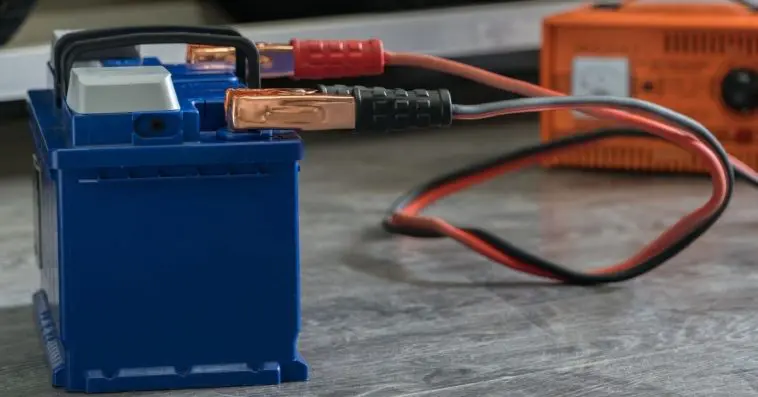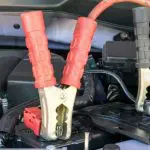There are multiple benefits to using a battery amp meter. Reading a Battery Charger Ammeter properly can help prolong your battery life and prevent any overcharging.
There is no need to fret; in this guide, I will teach you steps on reading your Ammeter in a simple and easy step-by-step guide.
TABLE OF CONTENTS
Steps On How To Read Your Ammeter
Below is the list of steps to take when reading your battery charger Ammeter.
You can follow these steps, and at the end of the article, you should be able to read your Battery Charger Amp Meter easily.
1. Disconnect Your Battery Clamps
First things first, you should disconnect your battery clamps from your car. The reason for disconnecting your battery clamps first.
After all, we will charge your batteries, not your car. Always do this before charging your battery, or else it can cause harm to you or your battery.
However, before doing any disconnecting, there are some precautionary measures that you must take.
These precautionary measures prevent any shock or danger hazards to your health and safety.
After taking the precautionary measures, you can now begin to disconnect your battery clamps to charge your batteries.
Always determine which are the positive and negative ports, and always unbolt the negative clamp before the positive clamp to prevent any shorting.
Below are the steps to take when disconnecting your battery clamps from your car.
Precautionary measures:
- Make sure your car is not turned on and running to avoid any hazards.
- Use proper Electrical equipment PPEs to prevent any shock, to prevent a possibility of your battery producing shocks and harming you in the process.
- Use safety glasses in case there is any spark or leaking to prevent any sparks from going into your eye.
- Do not wear any jewelry because there is a chance that the metal in your jewelry can produce a shorting on your battery.
- Cover the positive clamp with any clothing after you unbolt it because batteries produce explosive gas and can be harmful to your health.
How to disconnect your battery clamps?
- Use a screwdriver to unscrew the bolts from the clamps.
- Determine which is the negative and positive port by checking its color and the symbols. Usually, positive ports have a plus symbol on them, and negative ports have a minus symbol on them.
- Unbolt the nut of the negative port and disconnect your cable.
- Unbolt the nut of the positive port and disconnect your cable.
After doing these steps carefully, you should have successfully unbolted your battery clamps.
Always ensure that you disconnect your negative port first to prevent any shorting. Disconnecting your negative port first can prolong your battery life as well.
2. Connect Your Charger To Your Battery
After disconnecting your battery from your car, you should now connect your charger to your battery.
Usually, your charger includes specific instructions in their manual, so make sure you read them before proceeding.
Once again, you must determine which are the positive and negative terminal.
You can determine which is the positive clamp by looking at the plus symbol or its color red. The negative port is usually determined by a negative symbol or its black color.
You can now connect the charger to your car battery. After this, plug the charger into the electrical board to set the amp you want.
Most small batteries only need a 2 amp meter charger, while car batteries need a 10 amp meter charger.
After determining the charge rate you need, you can now turn on the switch. You would need to read your Battery Charger Ammeter afterward.
Below is the simple step-by-step guide on how to connect your battery charger to your battery.
- Read your manual for specific instructions if it comes with one.
- Determine which are the positive and negative terminal by looking for the plus and negative symbol or determining their color. Negative is usually black while Positive is usually red.
- Determine the type of battery you are charging; most small batteries only need a 2 amp charger, while car batteries need a 10 amp charger.
3. Reading Your Battery Charger Ammeter
Here comes the part you are waiting for the most, reading your Battery Charger Ammeter.
After plugging the charger into the electrical board, you would need to set your desired charge rate and read your Battery Charger Ammeter.
There are times when there are two needles in your manual Battery Charger Ammeter, and it can be confusing.
Do not fret, I will discuss teach you how to read a manual Battery Charger Ammeter with two needles as well.
Below are the steps to take when reading your Battery Charger Ammeter.
- Determine the charge rate you would like to use, smaller batteries can use a 2 amp charger, while almost any car battery use a 10 amp charger.
- Look at the display board of your charger carefully.
- Turn on the amp, and you will notice that the indicator will slowly move to the desired amp you set earlier.
- After your battery is charged fully, the needle will drop down and you are ready to start your car once again.
What if there are two needles in my Battery Charger Ammeter?
- The needle that is moving to your desired charge rate indicates the ampere.
- The other needle is the current charge of your battery.
- Follow the steps above to read your Battery Charger Ammeter.
4. Reading Digital Ammeters
High-quality Digital Ammeters usually come in digital form. These Digital Ammeters help you read the current amp or volt with ease because of its digital screen.
Aside from this, Digital Ammeters will help prevent any overcharging and prolong your battery life more.
However, this can be more costly than the manual Amp Meter, but the Digital Amp Meter is a good investment for convenient reading.
There are Digital Ammeters that have the option to read your Voltage as well, so make sure you are reading your Amp.
Below are the steps you should follow when reading your Digital Ammeter.
- Check if your Digital Amp Meter has a volt reading option.
- Make sure you are on the Amp reading option.
- The Amp reading should appear on the digital LED screen of you Digital Amp Meter.
Even though Digital Ammeters are more costly, you can read the amperes flowing in your battery much easily compared to a manual ammeter.
After following these steps, you should be able to read your Digital Amp Meter easily.
FAQs
Below are the most commonly asked questions about Batter Charger Amp Meters.
Q1. What Is The Difference Between Ammeter And A Voltmeter?
A voltmeter measures the voltage or difference between two points in an electrical circuit; both Voltmeter and Ammeter can have manual or digital meters that display their measurement.
An Ammeter measures the current that is flowing to the battery from the charger. Technically speaking, the Ammeter measures the Amperes of the device.
Make sure that when charging your battery, you are using an Ammeter, not a Voltmeter to determine the amperes and electrical current that is flowing to your battery.
Q2. Why Should I Use A Battery Charger Ammeter?
Getting a Battery Charger Ammeter is important and beneficial in many ways. Your Battery Charger Ammeter helps keep your battery full constantly and stop it from overcharging.
Overcharging can shed the material on the plates inside the battery; this can lower the capacity of your battery to charge.
Aside from this, a Battery Charger Ammeter helps you read the current electrical flow in your battery and determine how much it needs.
The Amp Meter also helps determine the electrical current output of your battery.
Q3. How Do I Know When The Battery Is Done Charging?
You would know when the battery is done charging when the needle moves down from the charger rate that you set.
The battery is also done charging when it drops to half of the desired amp that you said.
Q4. Why Is There More Than One Red Area On The Charger’s Amp Meter?
The charge rate you selected at the beginning represents the red area of the amp meter.
Meanwhile, the red area on the right is for high ampere charge rates. You would be able to determine the battery is fully charged when the needle drops to half of the needle that you set.
Conclusion
Using a Battery Charger Ammeter is beneficial in many ways.
A Battery Charger Ammeter helps prevent overcharging your batteries. Overcharging can cause your battery to lose the capacity to charge.
Reading your Battery Charger Ammeter is important to know how many amperes of current is flowing in your battery.
Knowing the number of amperes flowing in your battery can help prolong your battery’s life.
Reading a Battery Charger Ammeter can be intimidating at first.
However, just follow the simple steps included in this guide, and you would be able to read your Battery Charger Ammeter with ease.




